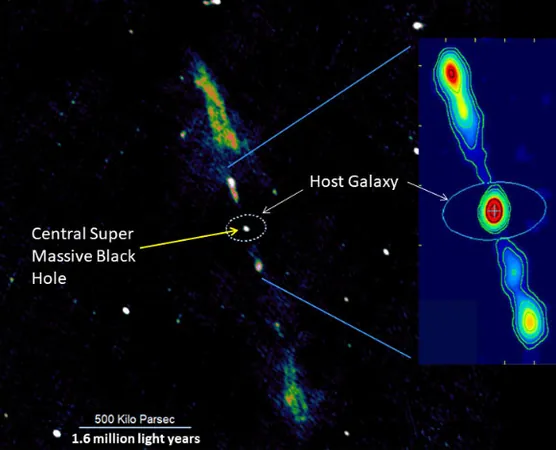
Shocking Discovery: Massive Spiral Galaxy is Launching Enormous Jets into the Cosmos!
2025-03-24
Author: Wei Ling
Discovery of 2MASX J23453268-0449256
In an astonishing revelation, scientists have identified an extraordinary spiral galaxy, 2MASX J23453268-0449256 (nicknamed J2345-0449), located nearly 947 million light-years away in the constellation of Aquarius. This galaxy not only boasts a supermassive black hole that is billions of times more massive than our Sun, but it is also expelling colossal relativistic jets that span an incredible 6 million light-years across. This feat makes J2345-0449 one of the largest known spiral galaxies exhibiting such powerful jets, challenging long-held beliefs regarding galaxy evolution, which have typically associated this kind of activity with elliptical galaxies exclusively.
Implications of the Discovery
Professor Joydeep Bagchi from CHRIST University commented on the implications of this discovery: "This finding compels us to reevaluate our understanding of galaxy evolution and the role that supermassive black holes play in shaping their surroundings."
The implications are staggering. If J2345-0449 can thrive and maintain its structure despite the powerful jets erupting from its core, what might this mean for our own Milky Way galaxy? Experts ponder whether our galaxy could one day experience similar high-energy events, potentially jeopardizing the delicate balance required for life.
Research Tools and Findings
The research team utilized advanced observational tools, including data from the NASA/ESA Hubble Space Telescope and the Atacama Large Millimeter/submillimeter Array (ALMA), to investigate J2345-0449's unique structure and evolutionary history. Surprisingly, they found that J2345-0449 is around three times the size of our Milky Way while still displaying well-defined spiral arms, a bright nuclear bar, and an undisturbed stellar ring, all in the presence of its massive black hole.
Unique Cosmic Features
Adding another layer of intrigue, J2345-0449 is enveloped by a vast halo of hot, X-ray-emitting gas. This cosmic feature not only hints at the galaxy's turbulent past but also plays a crucial role in its evolution. The study revealed that while the halo cools over time, the energetic jets from the black hole impede new star formation, despite the surrounding abundance of materials necessary for star creation.
The Role of Dark Matter
Furthermore, the researchers uncovered that J2345-0449 contains ten times more dark matter than the Milky Way, which is crucial for maintaining the stability of its rapidly spinning disk. As Shankar Ray, a Ph.D. student at CHRIST University, noted, "Understanding these rare galaxies could provide vital clues about the unseen forces governing the universe — including the nature of dark matter and the future fate of galaxies."
Conclusion
The groundbreaking findings are a significant step towards unraveling the cosmic mysteries that continue to fascinate astronomers and physicists alike. They emphasize that even in an era of advanced technology and understanding, the universe still has surprises waiting to be discovered. The full research is documented in the Monthly Notices of the Royal Astronomical Society, paving the way for a deeper exploration of our cosmos.
Stay Tuned!
Stay tuned as we continue to delve into the wonders of the universe!





 Brasil (PT)
Brasil (PT)
 Canada (EN)
Canada (EN)
 Chile (ES)
Chile (ES)
 Česko (CS)
Česko (CS)
 대한민국 (KO)
대한민국 (KO)
 España (ES)
España (ES)
 France (FR)
France (FR)
 Hong Kong (EN)
Hong Kong (EN)
 Italia (IT)
Italia (IT)
 日本 (JA)
日本 (JA)
 Magyarország (HU)
Magyarország (HU)
 Norge (NO)
Norge (NO)
 Polska (PL)
Polska (PL)
 Schweiz (DE)
Schweiz (DE)
 Singapore (EN)
Singapore (EN)
 Sverige (SV)
Sverige (SV)
 Suomi (FI)
Suomi (FI)
 Türkiye (TR)
Türkiye (TR)
 الإمارات العربية المتحدة (AR)
الإمارات العربية المتحدة (AR)